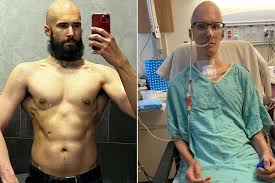What’s the worst that could happen after catching a cold? You feel sick for a few days, assumed 33-year-old Jared Maynard. However, he soon realized that he had been mistaken. What the Canadian powerlifter thought was a short bout of illness turned out to be just “the beginning of a nightmare.”
Introduction: A Common Cold Turns Tragic
Jared Maynard, a father of three and a dedicated powerlifter, never imagined that a mild cold would lead to a life-threatening condition. Early in 2023, after Jared and his family caught a mild cold, they all recovered within a week—except for Jared. His health began to deteriorate rapidly, marking the onset of a rare autoimmune disorder.
Initial Symptoms and Deterioration
From Mild Cold to Severe Illness
Initially, Jared’s symptoms mirrored those of a typical cold: fatigue, mild fever, and body aches. However, as days passed, his condition took a turn for the worse. His skin turned yellow, indicating jaundice, and he began experiencing severe delirium and organ failure.
The Hospital Admission
As Jared’s symptoms escalated, he was admitted to the hospital. The severity of his condition baffled doctors, who soon realized they were dealing with something far more serious than a lingering cold.
Diagnosis: Hemophagocytic Lymphohistiocytosis (HLH)
What is HLH?
Jared was diagnosed with Hemophagocytic Lymphohistiocytosis (HLH), a severe inflammatory syndrome caused by a hyperactive immune system. HLH is characterized by the body producing too many activated immune cells, which then start attacking the body’s own tissues and organs.
Symptoms of HLH
- Fever: Persistent high fever not responding to usual treatments.
- Jaundice: Yellowing of the skin and eyes due to liver dysfunction.
- Organ Failure: Severe cases involve multiple organ failure.
- Neurological Symptoms: Confusion, seizures, and delirium.
The Struggle for Survival
Critical Condition and Palliative Care
Jared’s condition worsened to the point where doctors began discussing palliative or end-of-life care. His family was devastated, facing the grim reality of potentially losing Jared.
Turning the Tables: A Ray of Hope
Despite the bleak prognosis, Jared’s story took an unexpected turn. His body began to respond to aggressive treatments aimed at controlling his hyperactive immune system. The medical team employed a combination of immunosuppressive drugs and other therapies to stabilize his condition.
Understanding HLH: The Medical Perspective
Causes of HLH
HLH can be triggered by various factors, including genetic mutations, infections, malignancies, and autoimmune diseases. In Jared’s case, it was a rare reaction following a common viral infection.
Diagnosis and Tests
Diagnosing HLH requires a combination of clinical evaluations and laboratory tests. Common tests include:
- Blood Tests: To check for elevated inflammatory markers and abnormal blood cell counts.
- Bone Marrow Biopsy: To identify abnormal histiocytes (immune cells) in the bone marrow.
- Genetic Testing: To identify potential genetic mutations linked to HLH.
Treatment Approaches for HLH
Immunosuppressive Therapy
Immunosuppressive drugs are the cornerstone of HLH treatment. These drugs help to calm the hyperactive immune response and prevent further tissue damage.
Chemotherapy
In some cases, chemotherapy drugs are used to suppress the immune system. This approach is often combined with immunosuppressive therapy for better outcomes.
Stem Cell Transplant
For patients with genetic forms of HLH, a stem cell transplant may be necessary. This procedure involves replacing the patient’s defective immune cells with healthy ones from a donor.
The Emotional Journey: Jared’s Family
Facing the Unthinkable
Jared’s diagnosis was a devastating blow to his family. His wife and daughters struggled to cope with the sudden and severe turn of events. The emotional toll of seeing their loved one in such a critical state was overwhelming.
Support Systems and Coping Mechanisms
Throughout Jared’s battle with HLH, his family leaned on a support network of friends, extended family, and healthcare professionals. They also found strength in each other, drawing closer in their shared ordeal.
Jared’s Road to Recovery
Gradual Improvement
After weeks of intensive treatment, Jared’s condition began to stabilize. His jaundice faded, and his organ functions started to recover. The journey was far from over, but these small victories provided hope.
Rehabilitation and Long-Term Care
Jared’s recovery process involved extensive rehabilitation. Physical therapy helped him regain strength, while ongoing medical care monitored his immune system to prevent relapses.
Lessons Learned and Awareness
The Importance of Early Diagnosis
Jared’s story highlights the critical importance of early diagnosis in managing HLH. Prompt medical attention and aggressive treatment can significantly improve outcomes.
Raising Awareness
Raising awareness about HLH and other rare autoimmune disorders is essential. Greater awareness can lead to earlier diagnosis, better treatment options, and improved patient outcomes.
A Story of Resilience and Hope
Jared Maynard’s battle with HLH is a testament to human resilience and the power of medical intervention. From a seemingly harmless cold to a life-threatening condition, his journey underscores the unpredictable nature of autoimmune disorders. Jared’s story is a beacon of hope for others facing similar challenges, reminding us all of the importance of perseverance and the strength of the human spirit.




